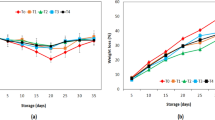Abstract
Opuntia ficus-indica well adapts to extreme climate conditions and grows rapidly in low water and poor soil requirement. In this study, the Opuntia ficus-indica fruit was used for natural dyeing of wool yarn. The Opuntia ficus-indica fruit has a reddish-purple color, due to the presence of water-soluble betalain colorants. When using this fruit as a natural dye, it is possible to obtain various color shades, because its color changes depending on the dyeing conditions. However, it is difficult to control the dyeing environment to reproduce the original color of Opuntia ficus-indica fruits. The aim of this study is to examine the effect of various dyeing conditions on the color strength, and color shades of Opuntia ficus-indica fruit. Ascorbic acid as a bio-mordant was applied for enhancing the stability of the betalain colorants. For this purpose, the betalain dye was extracted from Opuntia ficus-indica fruit by an aqueous extraction and used for dyeing wool samples in the presence of ascorbic acid at different dyeing process conditions. The dyed wool samples presented a red, pale red, orange, pale brown, and brown color by varying the applied pH (3, 5.5, and 8) of the dye bath, and dyeing temperature (40, 65, and 90 °C). Applying ascorbic acid as an antioxidant enhanced the color strength (~ 110%), thermal stability (~ 22%), and color fastness values. In addition, the presence of ascorbic acid did not have any significant effect on the tensile properties of the dyed wool yarns.








Similar content being viewed by others
Data Availability
All data generated or analyzed during this study are included in this published article.
References
C.-W. Kan, C.K.Y. Lo, W.S. Man, Color. Technol. 132, 4 (2016)
L. Lara, I. Cabral, J. Cunha, Sustainability 14, 8353 (2022)
P. Chowdhary, R.N. Bharagava, S. Mishra, N. Khan, in Environmental Concerns and Sustainable Development, 1st edn., ed. by V. Shukla, N. Kumar, vol. 1 (Springer Singapore, Singapore, 2020), pp. 235–256
M. Yusuf, M. Shabbir, F. Mohammad, Nat. Prod. Bioprospect. 7, 123 (2017)
P. Brudzyńska, A. Sionkowska, M. Grisel, Materials 14(13), 3484 (2021)
L.D. Ardila-Leal, R.A. Poutou-Piñales, A.M. Pedroza-Rodríguez, B.E. Quevedo-Hidalgo, Molecules 26(13), 3813 (2021)
M. Shahid, S.-U. Islam, F. Mohammad, J. Cleaner Prod. 53, 310 (2013)
C.E. Russell, P. Felker, Econ. Bot. 41, 433 (1987)
M. Aragona, E.R. Lauriano, S. Pergolizzi, C. Faggio, Nat. Prod. Res. 32, 2037 (2018)
E.M. Yahia, C. Sáenz, in Postharvest Biology and Technology of Tropical and Subtropical Fruits, 1st edn., ed. by E.M. Yahia, vol. 2, (Woodhead Publishing Limited, Cambridge, 2011), pp. 290–331
J.H. Cota-Sánchez, in Nutritional Composition of Fruit Cultivars, 1st edn., ed. by M.S.J. Simmonds, V.R. Preedy (Elsevier, Amsterdam, 2016), pp. 691–712
W.S. Choo, in Bioactive Molecules in Food-Reference Series in Phytochemistry, 1st edn., ed. by J.M. Mérillon, K. Ramawat (Springer International Publishing, Cham, 2018), pp. 1–28
P. Ganesan, T. Karthik, J. Text. Inst. 108, 1173 (2017)
A. Guesmi, N. Ben Hamadi, N. Ladhari, F. Sakli, Ind. Crops Prod. 37, 493 (2012)
N.F. Ali, R.S.R. El-Mohamedy, J. Saudi Chem. Soc. 15(3), 257 (2011)
A. Guesmi, N. Ben Hamadi, N. Ladhari, F. Sakli, Ind. Crops Prod. 42, 63 (2013)
K.M. Herbach, F.C. Stintzing, R. Carle, J. Food Sci. 71(4), R41 (2006)
A. Guesmi, N. Ladhari, N. Ben Hamadi, M. Msaddek, F. Sakli, J. Clean. Prod. 39, 97 (2013)
M.M. Giusti, R.E. Wrolstad, in Current Protocols in Food Analytical Chemistry, ed. by M.M. Giusti, R.E. Wrolstad (John Wiley and Sons, Inc., Hoboken, 2001), pp. F1.2.1.–F1.2.13
T. Fuleki, F.J. Francis, J. Food Sci. 33, 72 (1968)
H.M.C. Azeredo, Int. J. Food Sci. Technol. 44, 2365 (2009)
R. Castellar, J.M. Obón, M. Alacid, J.A. Fernández-López, J. Agric. Food Chem. 51, 2772 (2003)
R. Reynoso, F.A. Garcia, D. Morales, E. Gonzalez De Mejia, J. Agric. Food Chem. 45, 2884 (1997)
U. Merin, S. Gagel, G. Popel, S. Bernstein, I. Rosenthal, J. Food Sci. 52, 485 (1987)
J.M. Obon, M.R. Castellar, M. Alacid, J.A. Fernández-López, J. Biotechnol. 131, S139 (2007)
C. Albano, C. Negro, N. Tommasi, C. Gerardi, G. Mita, A. Miceli, L. de Bellis, F. Blando, Antioxidants 4, 269 (2015)
D. Butera, L. Tesoriere, F. Di Gaudio, A. Bongiorno, M. Allegra, A.M. Pintaudi, R. Kohen, M.A. Livrea, J. Agric. Food Chem. 50, 6895 (2002)
J.A. Fernández-López, L. Almela, J.M. Obón, R. Castellar, Plant Foods Hum. Nutr. 65, 253 (2010)
M.G. Miguel, Antioxidants 7(4), 53 (2018)
E. Akbar Hussain, Z. Sadiq, M. Zia-Ul-Haq, in Betalains: Biomolecular Aspects, 1st edn. (Springer International Publishing, Cham, 2018), pp. 125–137
E. Akbar Hussain, Z. Sadiq, M. Zia-Ul-Haq, in Betalains: Biomolecular Aspects, 1st edn. (Springer International Publishing, Cham, 2018), pp. 33–55
F. Delgado-Vargas, A.R. Jiménez, O. Paredes-López, Crit. Rev. Food Sci. Nutr. 40, 173 (2000)
H.E. Gharras, Nat. Prod. Commun. 6, 1425 (2011)
D. Cristea, G. Vilarem, Dyes Pigm. 70, 238 (2006)
C.H. Giles, J. Appl. Chem. 15, 541 (1965)
D. Gupta, Colourage 46(7), 35 (1999)
F.A. Faiz, J.S.K. Ngo, K.B. Bujang, Res. J. Text. Apparel 20, 74 (2016)
Acknowledgements
The authors would like to thank the support of the Department of Carpet, Faculty of Art, University of Birjand. Also, we appreciate and thank Mrs. Khaleghi, who helped during the implementation of this project in the Dyeing and Fiber Science lab, Department of Carpet, Faculty of Art, University of Birjand.
Author information
Authors and Affiliations
Corresponding author
Ethics declarations
Conflict of Interest
The authors declare no conflict of interest.
Supplementary Information
Below is the link to the electronic supplementary material.
Rights and permissions
Springer Nature or its licensor (e.g. a society or other partner) holds exclusive rights to this article under a publishing agreement with the author(s) or other rightsholder(s); author self-archiving of the accepted manuscript version of this article is solely governed by the terms of such publishing agreement and applicable law.
About this article
Cite this article
Barani, H., Rahmani, F. Dyeing of Wool Yarn with Aqueous Extract of Opuntia ficus-indica Fruit Containing Betalain Colorant Employing Ascorbic Acid as a Bio-mordant Under Varied Circumstances of Dyeing. Fibers Polym 24, 2785–2797 (2023). https://doi.org/10.1007/s12221-023-00274-w
Received:
Revised:
Accepted:
Published:
Issue Date:
DOI: https://doi.org/10.1007/s12221-023-00274-w




